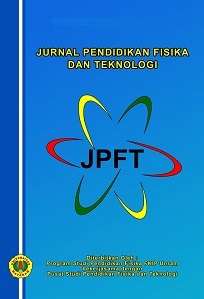Analisis Tingkat Kesulitan Soal Try Out Fisika SMA Negeri 5 Banda Aceh
DOI:
10.29303/jpft.v6i2.1457Published:
2020-12-01Issue:
Vol. 6 No. 2 (2020): Juli-DesemberKeywords:
analysis, difficulty level, try out questionsArticles
Downloads
How to Cite
Downloads
Metrics
Abstract
The purpose of this study was to see the difficulty level of physics exam questions at SMA Negeri 5 Banda Aceh in the 2018/2019 academic year. This type of research is a qualitative descriptive study. Those who will be the subjects of this research are students of class XII MIPA at SMA Negeri 5 Banda Aceh for the 2018/2019 academic year, who took the trial test determined by 32 students who were selected by lottery based on the list of participants in the trial test. Furthermore, the object of this research is a matter of trying physics for the 2018/2019 academic year originating from the Aceh provincial education office. The data test technique was carried out using documentation data, namely in the form of test questions for physics testing for the 2018/2019 academic year along with the student test scores. The data obtained were analyzed using the difficulty level formula (difficulty). The results of the data analysis showed that of the 40 items tested, only 7.5% of the items were too easy, 37.5% of the items were easy, 32.5% of the items were medium, 17.5% of the items that came were difficult difficult) and 5% of the answer items are too difficult (difficult). This shows that the physics experimental questions have varying levels of difficulty (difficulty).References
Arikunto. (2011). Dasar-Dasar Evaluasi Pendidikan. Jakarta: PT Bumi Aksara.
Harjanto. (2008). Perencanaan Pengajaran Jakarta: Rineka Cipta.
Riswida, L. (2014). Tingkat Kesukaran Dan Validitas Soal Try Out Mata Pelajaran Fisika Tahun 2011/2012 Pada SMA Se-Kota Banda Aceh. Skripsi. Banda Aceh: FKIP Unsyiah.
Safitri, E., Kosim & Ahmad H. (2019). Pengaruh Model Pembelajaran Predict Observe Explain (POE) Terhadap Hasil Belajar Ipa Fisika Siswa Smp Negeri 1 Lembar Tahun Ajaran 2015/2016. Jurnal Pendidikan Fisika dan Teknologi, 5(2), 197-204.
Sudijono, A. (2006). Pengantar Evaluasi Pendidikan, Jakarta: PT Raja Grafindo Persada.
Supeno, Sri, H.B., & Marlina, P.R. (2020). Karakteristik Kemampuan Siswa SMA Dalam Menyelesaikan Well dan Ill Structured Problems Pada Pembelajaran Fisika. Jurnal Pendidikan Fisika dan Teknologi, 6(1), 63-72.
Susilawati, E., Agustinasari, Achmad, S., & Parsaoran, S. (2020). Analisis Tingkat Keterampilan Berpikir Kritis Siswa SMA. Jurnal Pendidikan Fisika dan Teknologi, 6(1), 11-16.
Undang- Undang No.20 Tahun 2003 tentang Sistem Pendidikan Nasional.
Yusrizal. (2016). Pengukuran & Evaluasi Hasil Dan Proses Belajar. Yogyakarta: Pale Media Prima.
Author Biographies
Susanna Susanna, universitas syiah kuala
Putri Ani, Universitas Syiah Kuala
Abdul Hamid, Universitas Syiah Kuala
License
Authors who publish with Jurnal Pendidikan Fisika dan Teknologi (JPFT) agree to the following terms:
- Authors retain copyright and grant the journal right of first publication with the work simultaneously licensed under a Creative Commons Attribution License 4.0 International License (CC-BY-SA License). This license allows authors to use all articles, data sets, graphics, and appendices in data mining applications, search engines, web sites, blogs, and other platforms by providing an appropriate reference. The journal allows the author(s) to hold the copyright without restrictions and will retain publishing rights without restrictions.
- Authors are able to enter into separate, additional contractual arrangements for the non-exclusive distribution of the journal's published version of the work (e.g., post it to an institutional repository or publish it in a book), with an acknowledgement of its initial publication in Jurnal Pendidikan Fisika dan Teknologi (JPFT).
- Authors are permitted and encouraged to post their work online (e.g., in institutional repositories or on their website) prior to and during the submission process, as it can lead to productive exchanges, as well as earlier and greater citation of published work (See The Effect of Open Access).











